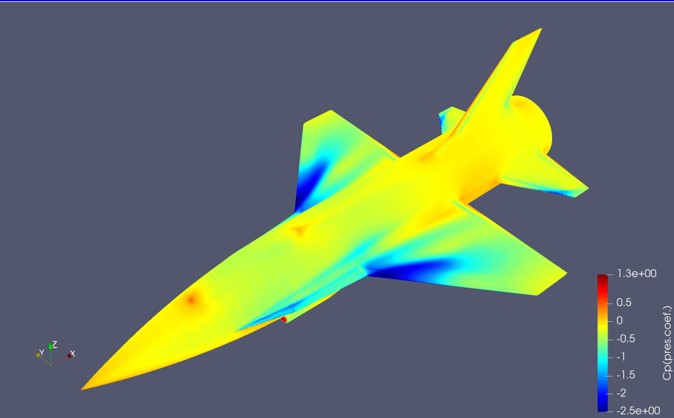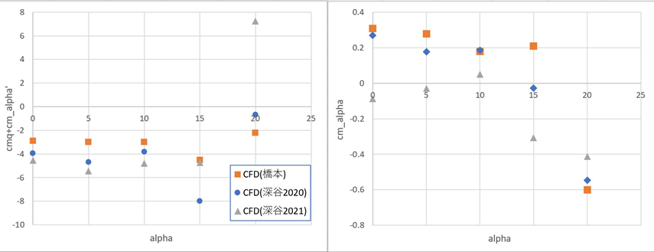Aerodynamic Properties measured using magnetic suspension and balanse system
JAXA Supercomputer System Annual Report February 2021-January 2022
Report Number: R21EDA201A03
Subject Category: Aeronautical Technology
- Responsible Representative: Hiroki Sugiura,Senior Researcher,Digital flight tech.team, Aircraft lifecycle innov. Hub,Aeronautical Technology Directorate
- Contact Information: Hiroki SUGIURA Senior Researcher,Digital flight tech.team, Aircraft lifecycle innov. Hub,Aeronautical Technology Directorate(sugiura.hiroki@jaxa.jp )
- Members: Hidehiko Fukaya, Daiki Kai
Abstract
An aerodynamic model and its identification method for investigating the variations of the pitch dynamic derivatives of a delta-wing aircraft model with respect to the angle of attack (AOA) were proposed in this study. Wind tunnel tests were conducted during two maneuvers: steady pitch sweep and pitch sweep with an overlaid 1 Hz pitch oscillation. To subtract the forces and moments that act under no-wind conditions from balance data during wind tunnel tests, no-wind forces and momentswere modeled using Gaussian basis functions. The extracted net aerodynamic forces and moments were processed to model and identify its characteristics using the dynamic derivative model.
Reference URL
N/A
Reasons and benefits of using JAXA Supercomputer System
JAXA Supercomputer enables us to conduct unsteady CFD calculations.
Achievements of the Year
Unsteady and steady RANS simulation of 2 oscillating aircraft models were conducted. One was a simple delta-winged model and the other was Standard Dynamics Model. The results for SDM model agreed well with Hashimoto's previous results.
Publications
- Non peer-reviewed papers
Dissertation "Identification of Unsteady aerodynamic properties of delta-winged aircraft using magnetic suspension and balance system" by Daiki Kai, 2022.
- Oral Presentations
Fukaya,Sugiura,Kai,Tezuka,"Identification of Dynamic Derivatives of Rolling Standard Dynamics Model without Support Interference",Aircraft symposium 2021, 2C01.
Kai,Sugiura,Fukaya,Tezuka,"Identifying Dynamic Derivatives from Beat Vibration Data Using Magnetic Suspension Wind Tunnel",Aircraft symposium 2021, 3B07.
Usage of JSS
Computational Information
- Process Parallelization Methods: N/A
- Thread Parallelization Methods: N/A
- Number of Processes: 1
- Elapsed Time per Case: 4 Hour(s)
JSS3 Resources Used
Fraction of Usage in Total Resources*1(%): 0.02
Details
Please refer to System Configuration of JSS3 for the system configuration and major specifications of JSS3.
| System Name | CPU Resources Used(Core x Hours) | Fraction of Usage*2(%) |
|---|---|---|
| TOKI-SORA | 12.20 | 0.00 |
| TOKI-ST | 139275.86 | 0.17 |
| TOKI-GP | 0.00 | 0.00 |
| TOKI-XM | 0.00 | 0.00 |
| TOKI-LM | 78.60 | 0.01 |
| TOKI-TST | 0.00 | 0.00 |
| TOKI-TGP | 0.00 | 0.00 |
| TOKI-TLM | 0.00 | 0.00 |
| File System Name | Storage Assigned(GiB) | Fraction of Usage*2(%) |
|---|---|---|
| /home | 20.00 | 0.02 |
| /data and /data2 | 200.00 | 0.00 |
| /ssd | 200.00 | 0.05 |
| Archiver Name | Storage Used(TiB) | Fraction of Usage*2(%) |
|---|---|---|
| J-SPACE | 0.00 | 0.00 |
*1: Fraction of Usage in Total Resources: Weighted average of three resource types (Computing, File System, and Archiver).
*2: Fraction of Usage:Percentage of usage relative to each resource used in one year.
ISV Software Licenses Used
| ISV Software Licenses Used(Hours) | Fraction of Usage*2(%) | |
|---|---|---|
| ISV Software Licenses(Total) | 0.00 | 0.00 |
*2: Fraction of Usage:Percentage of usage relative to each resource used in one year.
JAXA Supercomputer System Annual Report February 2021-January 2022




